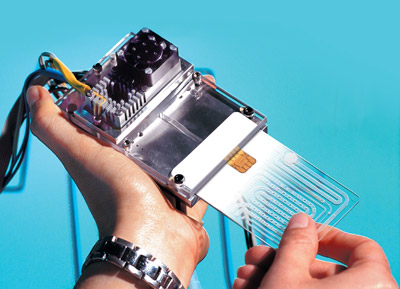Lab On a Chip or LOC is a novel technology based on microfluidics principle. It's a microfluidics device that integrates laboratory function only on a single chip sized in mm-cm. Microfluidics are mechanical flows devices. So its controlled only by very small amount of fluid, not more than a pico size.

This device can save scientist's time from weeks into not more than 24 hours at a crime scene or in a medical purpose. The applications of this device can be in biotechnology, medicine, clinical diagnostic, chemical engineering, and pharmaeutics.

This device seems beneficial right? But some scientist still in a big douvt of using this device in their job. Here are the advantages and disadvantages of LOC.
LOCs may provide advantages, which are specific to their application. Typical advantages are:
-low fluid volumes consumption (less waste, lower reagents costs and less required sample volumes for diagnostics)
-faster analysis and response times due to short diffusion distances, fast heating, high surface to volume ratios, small heat capacities.
-better process control because of a faster response of the system (e.g. thermal control for exothermic chemical reactions)
- cost effective
-safer platform for chemical, radioactive or biological studies because of integration of functionality, smaller fluid volumes and stored energies

But yet, it is still a novel technology and therefore it's not yet throughly developed. The low accuracy is not really ccan be ensure and may lead into wrong diagnostic or even the case become more complex.
Labels: device, diagnostic, genes-chip, lab on a chip, laboratory, microfluidics, technology





